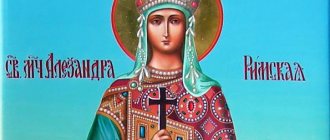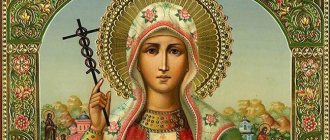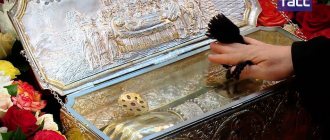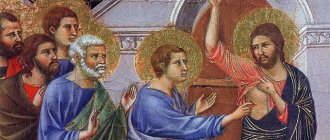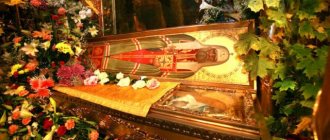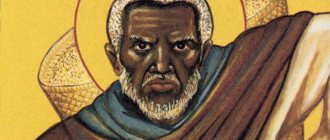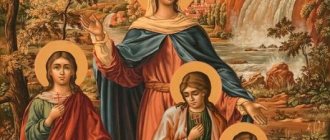Nowadays, the name Paraskeva (translated from Greek as “eve of the holiday” or “preparation for the holiday”) or Friday practically does not appear, except that the derivative Praskovya can occasionally be heard.
But in ancient times, parents called their beloved daughters by this name. This is due to the great veneration of the day of the week - Friday, as a reminder of the redemptive suffering of God.
Among them are the Paraskevi, glorified among the Saints. In Russia, the most famous are the Venerable Martyr Paraskeva of Rome and the Great Martyr Paraskeva Pyatnitsa. Their life stories are very similar, which often leads to confusion.
Life of the Roman Martyr
Paraskeva of Rome was born in the 2nd century. The parents were believers and for a long time asked the Lord for the gift of a child. Finally, they had a daughter. Because She was born on Friday, they decided to name her Paraskeva. From childhood she was introduced to Orthodox life.
After the death of her parents, Paraskeva distributed her property, took monastic vows, and, like the apostles, went to preach the Gospel throughout the world.
One day she was captured by the Roman Emperor Antoninus, in the hope of forcing the girl to renounce her faith and embrace idolatry. The girl was thrown into a cauldron of boiling resin, but she miraculously remained unharmed.
Useful materials
The emperor decided that the resin was cold and ordered it to be splashed in his face, receiving severe burns to his eyes and making him blind. Having prayed, he began to ask the martyr to heal him, and after his epiphany he accepted the Orthodox faith.
Released in peace, Paraskeva went to preach the Gospel to other cities. Also, due to the miraculous deliverances from death, which the pagans tried to give it to, many accepted holy Baptism and released Paraskeva to preach in different villages.
But one day she came to the lands where Emperor Tarasius ruled and she could not avoid execution. After much torment and torture, her head was cut off for her unshakable faith and heartfelt sermons. Crimeans claim that this happened on their land.
25
August
1864
A healing spring gushed out at the execution site, and a convent was built nearby.
Life of Paraskeva of Rome
Paraskeva’s parents could not have children for a long time, but they earnestly asked God to give them a baby. When the future righteous woman was born, her mother wanted to name her Venus, which in Latin translated as “Friday,” since it was on this day that she was born. However, the father of the newborn did not want his daughter to bear a pagan name, and chose another one that was close in meaning - Veneranda, which is a rough translation of the Greek name Paraskeva.
In childhood and adolescence, the girl studied the Holy Scriptures in her parents' home and received a good moral education. After the death of her relatives, Paraskeva gave away all her property and went to preach the word of God throughout Italy and Sicily. She became a nun. She carried the light of faith to the dark pagans. Some legends say that the saint always smelled a delicate scent of roses. Despite her youth and fragility, the girl showed resilience and fortitude, which earned her the wrath of the Roman authorities.
Emperor Antoninus Pius called the saint to court, where Veneranda continued to speak fearlessly about Christ. Seeing the powerlessness of words, the emperor ordered the executioners to torture the unfortunate woman. A red-hot helmet was put on Paraskeva and thrown into a cauldron of boiling tar. But the intercession of the heavenly forces manifested itself in such a way that the maiden remained unharmed. The amazed ruler looked into the cauldron, and the righteous woman splashed resin in his eyes. He became blind and began to beg Veneranda for help. Then the saint had mercy and with the word of God healed the emperor, after which she was released in peace.
Paraskeva continued her ministry. She went around the cities and preached to people. According to sources, the righteous woman converted many to Christianity, which again angered the local rulers. Ruler Temius subjected the righteous woman to new torments. Her breasts were cut off and then they brought her to the cave where the dragon lived so that the monster would kill the holy virgin. But Paraskeva crossed the beast with prayer, and it died.
And again Veneranda prevailed and was released. Then she fell into the power of Asclepius, who also tried to force the saint to renounce God, but failed. Paraskeva’s path ended in a city where the ruler was a certain Tarasius, who beheaded the righteous woman. It is believed that before her execution she was taken to the temple of Apollo to worship idols. The girl crossed herself, said a prayer, and the building collapsed.
Many miracles took place at the grave of Saint Paraskeva. People were healed, found what they had lost, found Divine protection and help through the prayers of the venerable martyr. Therefore, the people revered the memory of the righteous woman very much. And that is why so many traditions and legends are associated with the name of Veneranda. After all, over the centuries, people have carefully, bit by bit, collected and preserved stories about the nobility, virtues and purity of the saint.
Today there are monasteries and temples dedicated to her all over the world. Although the largest number of places associated with Paraskeva are still located in Western Europe. Particles of the saint’s relics are also kept in different parts of the world.
Miraculous icon
On the icons, the Venerable Martyr Paraskeva is depicted in the vestments of the ancient period, maforium (outer clothing, a long woman's veil, descending from head to toe) mainly in blue shades, which symbolizes heavenly purity and chastity.
There are icons both full-length and half-length. In her right hand she holds a cross, and in her left, in memory of the emperor’s deliverance from blindness, a copper bowl containing healed eyes. This cup is the main difference between the icon of Paraskeva of Rome and the faces of other saints Paraskeva, of which there were many in ancient times.
Iconography
The icons of Saint Paraskeva are marvelous works of religious art. The image depicts a young woman, beautiful in face and figure, dressed in simple blue clothes, which symbolizes her purity.
In the hands of the righteous woman is a cross and a plate with two eyeballs on it. This strange element is a reminder of the healing of the Roman emperor from blindness. The detail is the key difference between the saint and other righteous women with the same name.
Icons of the Venerable Martyr can be found in church shops or on the websites of various icon-painting workshops. An image of the saint is not at all superfluous to have in the house, since the protection and help of Veneranda protect people who turn to her.
Healings
Many miracles are performed through the prayers of Paraskeva of Rome for those who turn to her with faith, love and a pure heart.
Interesting fact
There is a well-known case when the icon of Paraskeva of Rome, discovered at the site of her execution and the origin of the source, saved the city of Mariupol from cholera in 1892. The saint appeared in a dream to a parishioner of the Church of the Nativity of the Virgin Mary and said that she needed to walk around the church with her icon and the cholera would recede. And so it happened.
Veneration in Orthodoxy
According to some legends, the Venerable Martyr Paraskeva died in the Crimea, in the Tolpu tract. And at the place of her execution, a healing spring soon began to flow. And centuries later, a convent was built near this place. A miraculous icon of the saint was also found here. The monks found it by chance in a stream and transported it to Mariupol, where the image saved the city from a cholera epidemic.
But, despite these assumptions about the Crimean execution, the relics of the righteous woman were kept for a long time in Constantinople, where a temple was built especially for them. Nowadays, parts of the relics of Paraskeva are in the Russian Panteleimon Monastery on Mount Athos.
And in Russia itself the Venerable Martyr is greatly revered. From the first years of Christianity, the Slavs built temples in honor of Veneranda and considered her day, Friday, special and holy. Researchers suggest that in the minds of medieval Russians, the image of a righteous woman replaced the original pagan female deities.
The memory of the saint in the Orthodox Church is celebrated on July 26 and August 8. On these holidays, it is customary to glorify the righteous woman with akathists and canons, thanking her for her assistance and assistance. This can be done both in church with brothers and sisters, and in prayer at home, in concentrated solitude.
Prayer to the Holy Martyr Paraskeva of Rome
Oh, holy and long-suffering Martyr Paraskeva! To you, like a warm prayer book for us to God, we fall down and pray diligently: beg our Lord and Master to add His mercy to us, His unworthy servants, to grant us mental and physical health, fruitfulness of the earth, goodness of the air, prosperity for Christians in piety, necessary and contented for temporary life, and everything necessary for salvation; Yes, having lived peacefully and piously, we will be honored to achieve a good Christian death and inherit the Kingdom of Heaven. To her, our good representative! Do not disgrace our hope, which, according to God and the Most Holy Theotokos, we place strong on You, but be an intercessor for our salvation, so that we, together with you and all the saints, in the joy of eternal bliss, glorify in your intercession the great mercy of our God, the Father, and the Son, and The Holy Spirit now, and ever, and unto ages of ages. Amen.
What does Paraskeva Rimskaya help with?
The saint prays on many occasions. A variety of reasons bring people to Paraskeva. But most often they ask her for healing from illnesses. After all, during her long life, the venerable martyr herself cured many people. Therefore, they ask her for healing from eye diseases and headaches, remembering the exploits of the righteous woman.
Another category of those who turn to Saint Paraskeva are women who would like to give birth. She herself was born only thanks to the long and humble prayers of her parents. Therefore, it is believed that she helps in this trouble.
The story of Saint Paraskeva Friday
Another, especially revered in Russia, Paraskeva was born a century later than Paraskeva of Rome, in Iconium. Her parents were very pious and strictly observed fasts on Wednesday and Friday.
They sacredly honored the day when the Savior suffered on the Cross, so they named their daughter Friday - in memory of this event. By their example of a righteous life, they instilled in the girl a strong faith in Christ and raised her to be a true Christian.
She was orphaned as a child, but her parents left her a rich inheritance. She happily shared it with the poor and disadvantaged and helped the sick. Being amazingly beautiful, Paraskeva, despite the abundance of suitors, firmly decided to give herself to the only Groom and become the bride of Christ.
She preached the Word of God with determination and exposed the pagans. She managed to convert many of the residents to Orthodoxy. But there were also those who hated her for her success in preaching.
And when the ruler came to the city to exterminate Christians, they joyfully gave him Friday. At first they tried to persuade her and seduce her to renounce her faith and worship idols.
Then she was subjected to all kinds of torture and torment - they flogged her with whips, tore her body with nails, threw her into prison, hoping that she would die from loss of blood. But the maiden, on the contrary, was just blossoming. Then they hung her on a cross and began to burn her with fire, but the fire burned only the tormentors, and the body of the martyr still remained unharmed.
Many, seeing such miracles, renounced idols and believed in Christ. But the angry ruler was not brought to his senses, and he ordered the unfortunate woman’s head to be cut off.
Image of the Great Martyr
In Rus', Paraskeva Friday was revered on a par with the Mother of God, which is why on the back of ancient icons of the Blessed Virgin you can often find an image of the Holy Great Martyr Friday.
Iconography: Paraskeva of Iconium (Friday), great martyr Dates: XIX century. Material: Wood, tempera Icon dimensions: height 40 cm, width 31 cm Redneck icon. Single-figure composition triumphantly, close-up, in front. On the head there is a white cloth, a crown, in the center of it, in the medallion of the Savior Not Made by Hands, in the right hand there is a cross, in the left he supports an unfolded scroll with the text. Colors of clothes: white, light ocher, the halo above the head is outlined with red ocher. The background is light, shot on gesso with circles and curls. Inv. No. KP 04550. © Kostroma State Historical, Architectural and Art Museum-Reserve
She was depicted at full height, a determined, unshakable ascetic, with a cross in her right hand and with the symbol of Faith in her left. Dressed in red maforia - the color of martyrdom and the blood that Christ shed for us on the cross.
There are images with fragments of Paraskeva’s hagiography. You can often find an icon of Paraskeva similar to the icon of the Mother of God “The Unbreakable Wall” or “The Intercession” with arms raised to the sky in prayer and outstretched to the sides. This type of image is called “Praying” or “Oranta” and symbolizes intercession before the Creator.
Water in a stream, well or spring was sanctified and acquired healing powers due to the fact that Paraskeva’s icons were often found on the water. That is why Paraskeva is considered the patroness of water, and throughout Russia there are many sources in honor of the great martyr. Temples and roadside chapels were dedicated to her.
Cases of miraculous intercession
Iconography: Paraskeva of Iconium (Friday), Great Martyr Dates: 17th century. Material: Wood, gesso, tempera Dimensions of the icon: height 79 cm, width 59 cm Frontal image of Saint Paraskeva Friday in full length with a scroll and a cross in her hands. Inv.-1159 ©Orenburg Regional Museum of Fine Arts
There are many known cases of healing or receiving what was requested from Paraskeva Pyatnitsa after pilgrimage trips and bathing in the springs or after a procession on the feast of Paraskeva.
For example:
“..after a pilgrimage trip in May, having prayed for the gift of a spouse, she got married in September of the same year..”
,
“...my legs hurt a lot, after visiting the source twice, I was healed...”
,
“...through the prayers of the Holy Great Martyr Paraskeva, after 6 months my daughter became pregnant; before that there had been no children for 10 years.”
Not only women, but also representatives of the stronger sex pray for a happy family life:
“... being divorced, I prayed in the church of the Holy Great Martyr Paraskeva at her miraculous icon about the arrangement of family life and made a vow to especially honor Friday - the day of the Savior’s suffering. Soon I met my future wife."
